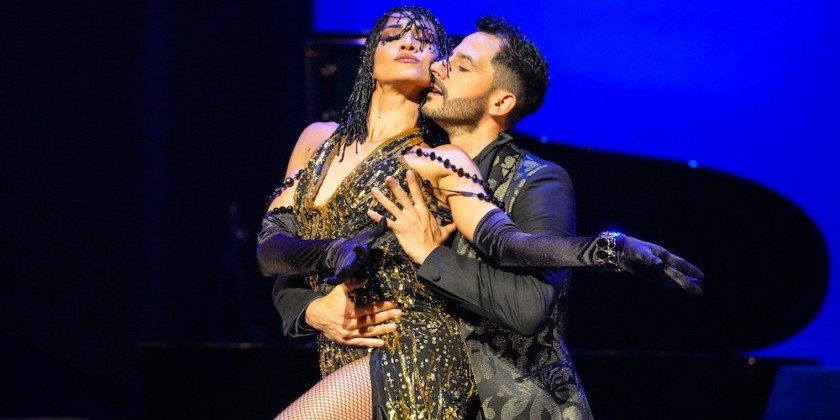AUDIENCE REVIEW: Nikki and The Noise at Cora Dance

Company:
Nikki and The Noise
Performance Date:
November 4, 2018
Freeform Review:
Nicole Assanti’s work happens in vortices. Powerful circles take thematic and spatial priority, evoking elemental events both human-made and natural: tides, tornadoes, merry-go-rounds, track and field races. These structures curtail and connect. They dissolve with the reach of a hand, becoming illusory and permeable. They withstand the impact of careening bodies hell-bent on wreaking havoc, morphing from wall into embrace. They serve as metaphors for refuge, alienation, and solidarity. The two pieces in Assanti’s solo show for her residency at Cora Dance with her all-female-presenting company, Nikki and The Noise, read as two sides of the same coin. When the lights go out, will you take me with you? and Emo Dances juxtaposed visions of community and individual strength with poignant vulnerability. The territory of each piece was fraught--tense, supportive, relational, reactive.
Though at times the relationship between the larger group and the individual dancers went unexplained, the persistent connection from solitude to collective action reinforced the underlying importance of the communal dynamic. Something flickered in the half-light of the small venue--a moody brew of trust, fear, and loyalty; a heady mix of comfort, defiance, and power.
This was not Assanti’s first rodeo, by any means: her choice-making was mature and consistent throughout the evening. Her work has been shown in venues such as Center for Performance Research, Triskelion Arts, Eden's Expressway, The Wick, Creative Cultural Center, Old First Reformed Church, DeBaun Performing Arts Center, Bridge for Dance, and the Brooklyn Conservatory of Music. Most recently, she co-directed and choreographed Corina Corina’s "Toothbrush" music video. The varied influences of her training and creative work elsewhere certainly showed up to support the content in When… and Emo Dances. Watching Assanti’s choreography felt like viewing a unified portfolio.
The first piece, When the lights go out, will you take me with you? had changed since I viewed it in its first iteration at Bridge For Dance. The lighting, stark and shadowy, raised the drama. Now, rather than playful, When… felt dire and dark. The material was spare, suspended, full-bodied; the choreographic focus lingered on a duet filled with Assanti’s signature style of richly-detailed partnering. (Despite the duet’s beauty, I would have relished a chance to see the other dancers more clearly.) The unresolved intimate tension between the partners strained for a disruption. Significant glances flew from the side lines as limbs locked and bodies rolled. Dancers stepped into the realm of the duet at critical junctures to intercede in the flailing machinations of what could have been violence or love. Tableaux evoking departure, consolation, and apprehension dissolved into looping, stomping phrases and compact floorwork. When... was the heavy air before a hailstorm, or the grey atmosphere after a fight. Additionally, the audience sat in the round, which proved the biggest and smartest change. If the work functions in circles, as Assanti’s pieces do, looking at the circles from their outer boundaries creates a unique precariousness for the audience. We were, in a way, part of the action. The group performed the spectatorship the audience engaged in; the fluidity between watcher and watched infused this piece and the next with raw, live energy.
The theatricality demanded by Emo Dances came off well. Nothing felt forced; the quirkiest moments were earned. A distinct ludic, dreamlike quality juxtaposed the seriousness of the first piece. Emo Dances felt like thumbing through a high school yearbook collage while putting your 2011 iPod Nano on shuffle. Most of us had an “emo phase” and it passed unremarked. Emo Dances, though, unpacks the details and stakes within that hackneyed teenage trope with big, earnest effort. Fantastical failures and successes abounded, as well as hyperbolic feelings, headbanging, shoe-throwing, guitar-shredding, pillow-punching, and guts-and-glory gusto. The intricate, muscular partnering of the first piece returned, but looked more like gym class or recess-time wrestling in this context. Deadpan comedic timing and clever musical interpretations set against a soundtrack of familiar tunes from My Chemical Romance and Fall Out Boy established a silliness that held up against the raw aggression pulsing underneath the movement. Themes of contest, effort, defense, and unity fought for priority. The dancers vied for attention while they performed arbitrary feats of strength, intensity, and support.
Assanti’s showing left me with questions I believe she will continue to answer in future iterations of these works or in entirely new creations. On the whole, the Nikki and The Noise delivered on fierce performativity. The cast was game for any challenge. Both pieces were danced deliberately, with attention, bravado, and abandon. Assanti’s work proved full of luminous, jostling causality, of witnessing, watching, pulling, pushing, holding and being held. The weighty tenderness and heavy, awkward joy of her dances asks, Where does competition end and community begin? Where does strength give way to support? Where are we in the darkness of our deep emotions?
Author:
Dot Armstrong
Website:
https://dtrmstrng.weebly.com/












